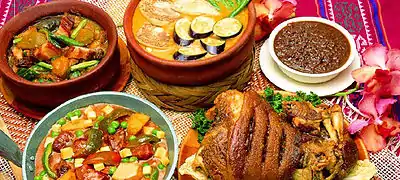_02.jpg.webp) | |
| Alternative names | kinamo, kinamut, boodle fight |
|---|---|
| Place of origin | Philippines |
| Other information | Sadya |
.jpg.webp)

| Part of a series on |
| Meals |
|---|
 |
| Meals |
| Components and courses |
| Related concepts |
Kamayan (Tagalog for "[eating] with the hands"), also known as kinamot or kinamut in Visayan languages, is the traditional Filipino method of eating with the bare hands. It is also used to describe the Filipino communal feast (also called a salu-salo) where food is served on banana leaves and eaten without utensils.[1][2][3]
Another term for kamayan is boodle fight which is used in the context of the military practice of eating a communal meal.[4][5][6][7]
Etymology
Both "kamayan" and "kinamot" mean "[eating] with the hands", from the root words kamay and kamot, both meaning "hands".[8] "Salu-salo" means "feast" or "banquet", a reduplication of salo, "to eat together" or "to share food".
The name "boodle fight", on the other hand, likely originated from the term "boodle", which is American military slang for contraband sweets[9] such as cake, candy and ice cream. A "boodle fight" is a party in which boodle fare is served.[10] The term may have also been derived from "kit and caboodle"; caboodle is further derived from boodle or booty.[11]
History
The practice of kamayan is pre-colonial. It has been described in by Antonio Pigafetta in the Magellan expedition, as well as by Spanish missionaries during the Spanish colonial period. While utensils like wooden spoons and ladles existed for serving and cooking in pre-colonial Filipino culture, they were not used for eating.[2][12][13]
The practice was tolerated during the Spanish period, but it was suppressed during the American colonial period when American dining etiquette and the use of spoons and forks were aggressively promoted.[14][15]
Description
Kamayan describes the act of eating with the bare hands, which is the traditional pre-colonial method of eating in Filipino culture. This is done by forming a small mound of rice, adding a piece of the accompanying dish for flavor (the ulam), compressing it into a small pyramid with the fingers, lifting it to the mouth nestled in four cupped fingers, and then pushing it into the mouth with the thumb. The entire process only uses the fingers of one hand. It never uses the palms of the hands and the fingers also never enter the mouth. The other hand is not used and may instead be used to hold the plate or a drink.[3][16][17]
Kamayan also describes the traditional communal feasts or family meals, where rice and various colorful dishes are placed on banana leaves and eaten together. The banana leaves are washed and slightly wilted over open flames to bring out an oily sheen and then laid out on a long table.[18] In the Batanes Islands in the northern Philippines, large breadfruit (tipuho) leaves are used instead in a serving tradition called vunung or vunong.[19]
The dishes are arranged equidistantly throughout the table to ensure everyone has equal access. Rice are typically plain steamed white rice that is not too mushy, sinangag (garlic rice), or rice cooked in coconut leaves (puso). Typical dishes aside from rice, includes inihaw (barbecues, including lechon, whole roasted pork), lumpia, fried meats (like crispy pata), tocino (cured pork), tapa, longganisa (sausages), pancit (noodles), boiled eggs or salted eggs, seafood, dried fish, and blanched, fresh, or stir-fried vegetables. These are provided with a variety of sawsawan (dipping sauces), calamansi, bagoong, as well as pickled vegetables (atchara). Desserts are also included, like ripe or unripe Philippine mangoes, pineapples, watermelons, papaya, young coconut, leche flan, and various kakanin (rice cakes). Drinks are usually fruit juices, beer, wine, or softdrinks. As a rule, soups and stews are not included.[18][3][20][21][22]
Kamayan is an informal and intimate method of dining. It has a general atmosphere of sharing, and participants usually talk throughout the meal. It does not have the strict etiquette and rules of western dining, and the dishes served depend on what is available. Kamayan may be done in private family meals or in gatherings, parties, picnics, or fiestas. A growing number of Filipino restaurants are serving meals kamayan-style.[2][8][18]
Boodle fight
A boodle fight is a meal that dispenses with cutlery and dishes.[23] Diners instead practice kamayan.[24] The food is placed on top of a long banana leaf-lined trestle table and in the true military practice, diners do not sit in chairs but instead stand shoulder to shoulder in a line on both sides of the table.
A senior officer or enlisted personnel then utters the traditional command for the boodle fight to begin:
"Ready on the left,
Ready on the right,
Commence boodle fight!"
See also
References
- ↑ "The practice of kamayan and how it fosters Pinoy pride". Rappler. 11 December 2018. Retrieved 22 August 2021.
- 1 2 3 Makalintal, Bettina (20 January 2018). "With A Show Of Hands, Filipino-American Chefs Rekindle Kamayan Feasts". NPR. Retrieved 22 August 2021.
- 1 2 3 Abbey, Francis (18 November 2019). "Love and pork - The Filipino feast you eat with your hands". WUSA9. Retrieved 22 August 2021.
- ↑ Dumdum Jr., Simeon (10 June 2012). "The boodle fight". Philippine Daily Inquirer. Retrieved 19 March 2008.
- ↑ Altheyie. "Boodle fight and the battle of Filipinos – A preview of OFW's life in Canada". Retrieved 16 June 2017.
- ↑ Marcaida, Joana Joyce (26 August 2015). "The boodle fight". Retrieved 16 June 2017.
- ↑ "What is a Boodle Fight? - Ang Sarap". Ang Sarap (A Tagalog word for "It's Delicious"). 2015-05-21. Retrieved 2020-02-10.
- 1 2 Sogn, Jamie (9 August 2017). "Filipino Kamayan Dining from the San Fernando Valley to the Mission". KCET. Retrieved 22 August 2021.
- ↑ Dolph, Edward Arthur (1942). "Sound off!" Soldier Songs from the Revolution to World War II. Farrar & Rinehart. p. 579.
- ↑ Dickson, Paul (2014). War Slang: American Fighting Words & Phrases Since the Civil War. Courier Corporation. p. 132. ISBN 978-0486797168.
- ↑ "Whole kit and kaboodle". World Wide Words. April 10, 1999. Retrieved May 16, 2012.
- ↑ Kohnen, Norbert; Kohnen, Petra (1986). Igorot: Traditional Ways of Life and Healing Among Philippine Mountain Tribes. SDK Systemdruck Köln GmbH.
- ↑ Limos, Mario Alvaro (11 March 2021). "These Precolonial Filipino Words Recorded by Pigafetta Are Still Used Today". Esquire. Retrieved 22 August 2021.
- ↑ Ting, Jasmine P. (4 January 2019). "Cooking for the Kamayan". Saveur. Retrieved 22 August 2021.
- ↑ Greaves, Vanessa (29 September 2020). "Getting in Touch Through Kamayan, the Ultimate Filipino Feast". allrecipes. Retrieved 22 August 2021.
- ↑ "Kamayan - Eat Using Your Hands Culture". Filipino-Recipe.com. Retrieved 22 August 2021.
- ↑ "Use Your Hands: Traditional Filipino Way of Eating". Primer.com.ph. Retrieved 22 August 2021.
- 1 2 3 Mendiola, Idge (8 July 2019). "How to Create a Boodle Fight: A Guide to This Easy but Festive Way of Entertaining". Esquire. Retrieved 22 August 2021.
- ↑ "The Ivatan Cuisine: Must-Try Batanes Dishes". The Girl Behind The Pen. Retrieved 17 June 2022.
- ↑ "Cebu's 'puso'". SunStar Philippines. 19 May 2013. Retrieved 22 August 2021.
- ↑ Chavez-Bush, Leigh. "Kamayan: These epic Filipino feasts feature lavish spreads and forego utensils". Atlas Obscura. Retrieved 22 August 2021.
- ↑ "How To Prepare A Boodle Fight At Home, a.k.a. "Kamayan Feast" on Banana Leaves". Jeanelleats. Retrieved 22 August 2021.
- ↑ Boorman, Charley (2009). Right To The Edge: Sydney To Tokyo By Any Means: The Road to the End of the Earth. Hachette. ISBN 978-0748113156.
- ↑ Lowry, Dave (6 January 2016). "Hand-to-Mouth Combat: Experiencing a Kamayan Dinner at Hiro Asian Kitchen". Retrieved 16 June 2017.
External links
 Media related to Boodle fight at Wikimedia Commons
Media related to Boodle fight at Wikimedia Commons
